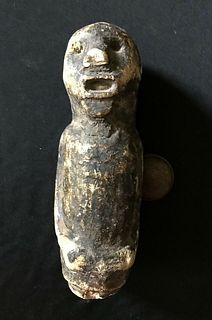Impressive Greco-Romano Marble Stela, Ex Christie's
Lot 36
About Seller
Artemis Fine Arts
686 S Taylor Ave, Ste 106
Louisville, CO 80027
United States
Selling antiquities, ancient and ethnographic art online since 1993, Artemis Gallery specializes in Classical Antiquities (Egyptian, Greek, Roman, Near Eastern), Asian, Pre-Columbian, African / Tribal / Oceanographic art. Our extensive inventory includes pottery, stone, metal, wood, glass and textil...Read more
Estimate:
$10,000 - $15,000
Absentee vs Live bid
Two ways to bid:
- Leave a max absentee bid and the platform will bid on your behalf up to your maximum bid during the live auction.
- Bid live during the auction and your bids will be submitted real-time to the auctioneer.
Bid Increments
| Price | Bid Increment |
|---|---|
| $0 | $25 |
| $300 | $50 |
| $1,000 | $100 |
| $2,000 | $250 |
| $5,000 | $500 |
| $10,000 | $1,000 |
| $20,000 | $2,500 |
| $50,000 | $5,000 |
| $100,000 | $10,000 |
| $200,000 | $20,000 |
About Auction
By Artemis Fine Arts
Oct 7, 2021
Set Reminder
2021-10-07 10:00:00
2021-10-07 10:00:00
America/New_York
Bidsquare
Bidsquare : Exceptional Antiquities Ethnographic Fine Art
https://www.bidsquare.com/auctions/artemis-gallery/exceptional-antiquities-ethnographic-fine-art-7537
Museum-worthy examples of Egyptian, Greek, Roman, Etruscan, Near Eastern, Far East / Asian, Pre-Columbian, African / Tribal, Oceanic, Native American, Spanish Colonial, Fossils, Ancient Jewelry, Fine / Visual Arts, so much more! Artemis Fine Arts info@artemisgallery.com
Museum-worthy examples of Egyptian, Greek, Roman, Etruscan, Near Eastern, Far East / Asian, Pre-Columbian, African / Tribal, Oceanic, Native American, Spanish Colonial, Fossils, Ancient Jewelry, Fine / Visual Arts, so much more! Artemis Fine Arts info@artemisgallery.com
- Lot Description
Greco-Romano culture, late Hellenistic to early Roman, ca. 2nd to 1st century BCE. A magnificent marble stela of pentagonal form, skillfully carved with the relief of a funerary banquet between a male and female and topped with a 3-lined Greek inscription dedicated to the wife of Atiphos, who lived to be 60 years old, and his son Roupheinos, who lived to be 21. On the right, the male lays semi-recumbent on a small bed, leaning with his left elbow atop a pillow. His left hand holds a drinking cup, while his right is raised and bears a wreath - a popular funerary motif. The woman sits to the left, draped in a himation to convey mourning, the corners of which she grasps in each hand, as she points upwards with her left arm. A petite table is shown before them. Size: 20" L x 2.6" W x 18.7" H (50.8 cm x 6.6 cm x 47.5 cm)
Prior to the 2nd century, Romans cremated their dead; around that time, inspired by the Greek and Etruscan practice of using sarcophagi, they began to place their dead in sarcophagi. This trend spread rapidly throughout the Roman Empire. In the western part of the Empire, sarcophagi were placed inside a mausoleum against a wall or in a niche, so the only decorated panels were on the front and the short sides. This stele probably came from the grave of a high-status Roman citizen.
A carved relief stele such as this one was part of a long tradition of marking the graves of elite and even some middle-class Greek citizens. This item would have once been brightly painted. The pentagonal form of the stele is meant to imitate a small temple known as a naiskos.
Similar examples can be found at the University of Pennsylvania Museum of Archaeology and Anthropology under object number MS4023 and as no. 277 in "Sculpture in Stone, The Greek, Roman and Etruscan collections of the Museum of Fine Arts, Boston" by Mary B. Comstock and Cornelius C. Vermeule (Boston, 1976).
This piece has been searched against the Art Loss Register database and has been cleared. The Art Loss Register maintains the world’s largest database of stolen art, collectibles, and antiques.
Provenance: ex-private New Jersey USA collection, acquired prior to 2000; ex-Christie's New York, June 14, 1993, "Antiquities" (Auction 7694), lot 94
All items legal to buy/sell under U.S. Statute covering cultural patrimony Code 2600, CHAPTER 14, and are guaranteed to be as described or your money back.
A Certificate of Authenticity will accompany all winning bids.
PLEASE NOTE: Due to recent increases of shipments being seized by Australian & German customs (even for items with pre-UNESCO provenance), we will no longer ship most antiquities and ancient Chinese art to Australia & Germany. For categories of items that are acceptable to ship to Australia or Germany, please contact us directly or work with your local customs brokerage firm.
Display stands not described as included/custom in the item description are for photography purposes only and will not be included with the item upon shipping.
#167849Softening of finer details in areas, especially on top and sides of inscription. Losses to nose and mouth area of both figures. Expected surface wear with some nicks and abrasions. Otherwise, excellent.Condition
- Shipping Info
-
All shipping is handled in-house for your convenience. Your invoice from Artemis Gallery will include shipping calculation instructions. If in doubt, please inquire BEFORE bidding for estimated shipping costs for individual items.
-
- Buyer's Premium



 EUR
EUR CAD
CAD AUD
AUD GBP
GBP MXN
MXN HKD
HKD CNY
CNY MYR
MYR SEK
SEK SGD
SGD CHF
CHF THB
THB
















